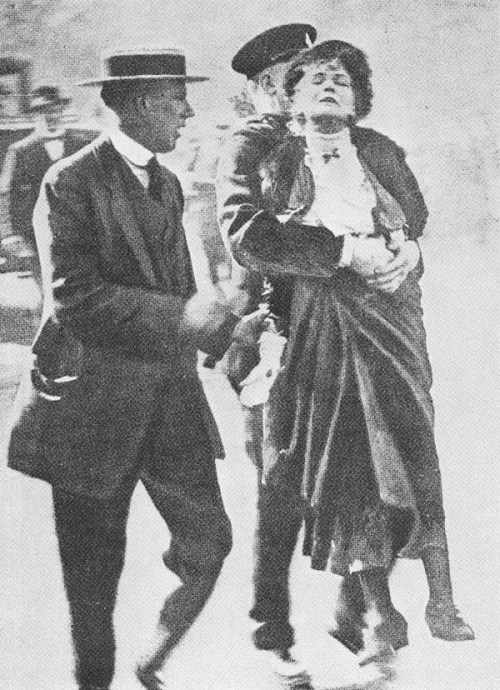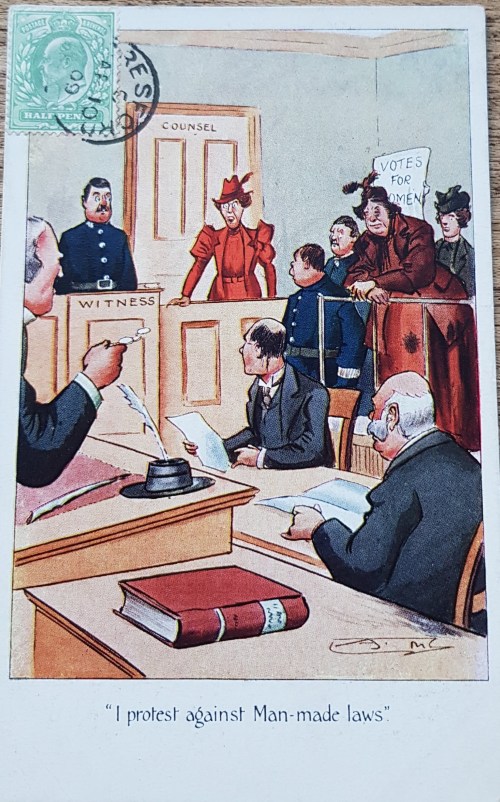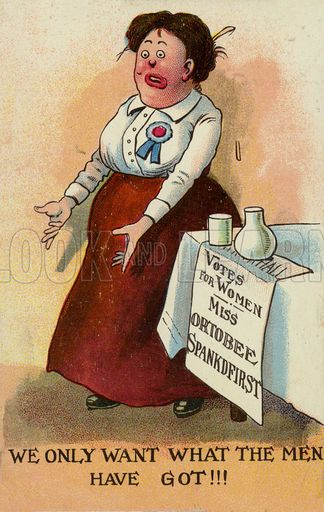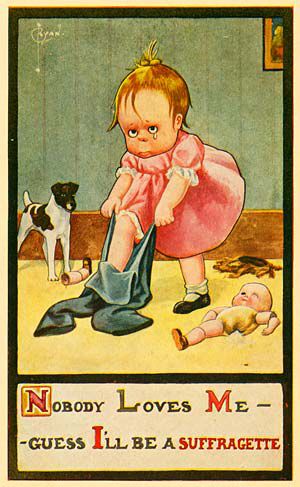In my post Suffragettes – Pictures say a Thousand Words, I touched on the subject of Edwardian propaganda. The battle (as at times it was a battle) for women to achieve the vote, is remembered this centenary year of the Representation of the People Act which permitted some women who met property rules, the right to vote.
Suffragists, like Millicent Fawcett, used diplomacy and law-abiding methods to convince parliament to change legislation in favour of the enfranchisement of women. However, during the early 1900s, with Fawcett’s quiet pressure going nowhere, new more visible protagonists entered stage left.
The Women’s Social and Political Union (WSPU) lead by Emmeline Pankhurst and two of her daughters, Christabel and Sylvia, rallied loud and membership grew with like-minded women who were willing to subvert social mores. Their campaign for woman suffrage became increasingly violent and those wishing to shake the male patriarchy to its knees suddenly had their leaders who were willing to make headlines.

Soon they were labelled suffragettes, it was a term coined by a national newspaper intending to belittle and besmirch their intentions, but the WSPU latched onto the new name which differentiated themselves from their more peaceful counterparts. The term suffragette was synonymous with militancy, lawlessness and vociferous and lively agitators who were not afraid to upset the established social order.
Anti-suffrage campaigners used picture postcards to publicise their opposition to women gaining electoral equality with men. It was an easy way to propagandise an argument and without modern technology, the post was the conduit for spreading discourse from both sides of the argument. They mocked suffragettes as ugly rabble-rousers, unfeminine and poor mothers as their priorities were not focussed on home and family – they were the total antithesis of what females were supposed to be.

The postcards that survive this era offer a glimpse of the vitriol that was directed at suffrage campaigners. The one above is mild in comparison to some and portrays an overweight female with a blackened eye, presumably after fighting with the policeman witness. I previously used this image to illustrate a blog post. This week I have bought my own copy. Collecting suffragette postcards can be an expensive hobby so I may be slow to build up a collection. Images though can be found online.

The card above featuring the suffragette Madonna is from an American series of anti-suffrage cards. It portrays the perceived emasculation of men who would be left in command of women’s work if the women of the house were agitating for voting rights. Fears of female autonomy were the same on both sides of the Atlantic.

Presumably, the unattractive rotund female, sporting unkempt hair above, is meant to be Christabel or Sylvia Pankhurst as the title is ‘Miss’ rather than ‘Mrs’ for the matriarch of the family. As with other depictions of suffragettes, this derivation of Pankhurst into Spankdfirst informs the reader that the suffragette is akin to a recalcitrant child who needs spanking.

The card above is comprised of classic suffragette colours of green and purple. The suffragette dressed in purple is being chased by a policeman. The card suggests that she turn over a new leaf and become the epitome of womanhood, a pink-garbed blonde, cradling a baby. Its tag-line ‘Happy New Year to a New Woman’ subliminally suggests that females would be happier subscribing to gender norms and acting on maternal instincts.

The image above depicts a pouting female child who is about to become a suffragette. She has been crying and is surrounded by broken toys further demonstrating her immaturity. She is also in the process of dressing in male clothing – note the trousers she is donning as she is trying to step into the male sphere. Its catchphrase ‘Nobody Loves Me’ is informing womankind that if they follow this route they will remain unloved and alone.
Mass produced postcards that were cheap to buy and cheap to post were ever-present in the pre-mass-communication early twentieth century. The cards that survive show that both sides of the suffrage argument could cleverly twist facts into glorious copy. What a gift to the caricaturists and writers was the name Pankhurst when you can turn it into Spankdfirst?
However, whilst some postcards amused, others depicted the crueller side of opposing women the right to vote. Many displayed scenes of torture, propagandised threats to females promising that this would be their fate if they followed in the Pankhursts’ shoes, for example, being tied to a chair or force-fed like the images below. Not a fate for genteel Edwardian ladies, but one that befell the women who fought for equal voting rights who are rightly remembered this centenary year.
If you would like to read more about postcards you may like to read a post dedicated to Using Postcards for Family History.
If you would like to read about suffragettes attacking the post click here.
Images from Pinterest unless stated.




Outstanding post, post modern propaganda. Thanks for sharing. I wonder what the other side of the story is concerning the suffragettes. I know the approved story is of oppressive white men and enslaved women. But is there another side to the coin as they say?
LikeLiked by 1 person
Thanks so much! The suffragettes fought tooth and nail, but then WWI intervened.
I think the argument is still raging – women have so much more than they did 100 years ago, but we still see much inequality. Look at today at the US open with the female tennis player reprimanded for doing what her male counterparts do all the time!
LikeLiked by 1 person
I thought when the suffragettes were fighting for the right to vote, they were only the wives of rich husbands. Since, then in order to vote, there were other responsibilities that went along with that. Such as serving on the fire brigade, paying taxes, etc.. I could be wrong, but I don’t think it’s as black and white as it is made out to be. The rich wives could easily get others to fulfill their new responsibilities, whereas, the poor women, just got stuck with more stuff and responsibilities on top of what they already had.
I don’t understand why women want to be as disposable as men to be quite honest.
I look forward to your response.
LikeLiked by 1 person
Without more industrious research my response is a little limited, unfortunately. I work outside the history field and it’s been four years since I left my Master’s degree so I don’t have my head in academic books as often as I’d like. That said, there is renewed interest and scrutiny into the working class women who fought for the vote. You’re right to say that previously it was thought that it was middle-class women who had the time to agitate for the vote, but recent research has found more information on working class suffragettes, like Annie Kenney and Louisa Entwistle.
Women of the working classes were quietly active in their own way, like my grandmother. She had to work along with her husband to support her growing family. Sadly she died before I was born, and I don’t know her thoughts, but women of her ilk were paying taxes etc. and contributing to society and deserved the change in 1918, although full female suffrage though did not occur until 1928.
LikeLiked by 1 person
I’m not arguing against equal rights. I just tend to not believe the narrative, it often seems too convenient to fit the narrative of today. It just seems that the rights are already there, whereas, women who want to fight in combat, yet there is no requirement for women to sign up for selective service once they turn 18.
The rights that are clamored about seem very selective as well. In the porn industry, men are paid a fraction of what the women are paid.
I don’t think the discussion taking place is honest in any facet.
LikeLiked by 1 person
I’m not going to lie, you referencing the porn industry disturbs me. There is no reason for that and it makes me uncomfortable.
To return to the blog that I posted, there are many sides to the story of the votes for women campaign and I have touched on only a small part. There were the anti-suffrage campaigners (men and women), there were the suffragists who used diplomacy and there were the suffragettes who were militant in their actions (and their supporters included some men). Many women, regardless of class, supported the votes for women campaign.
I am anti-violence and some of the suffragette militancy was criminal and I cannot condone their actions but then the women were treated with state-sanctioned violence in response. It is a subject that warrants a book rather than a word-limited blog post.
LikeLiked by 1 person
Such vitriol. It’s sad to see such hatred and ridicule.
LikeLiked by 1 person
The humorous cards do amuse but other really make you stop. When you know the history of forced feeding it’s hard to see the amusement and entertainment in such as the women were abused horrifically in prison.
LikeLiked by 1 person
Glasgow Women’s Library has a good collection of these. Interestingly, some have been used and the messages have no bearing on the Suffragette cause, pro or anti. “I’ll be round for tea” and similar. Very strange.
LikeLiked by 1 person
The seller I bought my card from only had 2. One was dated 1921 and clearly not of the suffragette era and the other was one I’d seen before 😦 I do think that the other one was a more feminist postcard rather than anti or pro suffragist/suffragette. I’ll try to visit the Women’s Library the next time I’m in Glasgow.
LikeLike
Good idea! If you want to see specific items you would need to get in touch first though.
LikeLiked by 1 person
Awesome post. Thank you for sharing it! Extraordinary images that showed how awful people could be to women who dared to challenge the system.
LikeLiked by 1 person
Thanks – shall I tell you a secret? It was just a post with me sharing a postcard I had bought, but I got carried away. I wrote until 2 in the morning!
LikeLiked by 1 person
Thank you! I’m glad you did!
LikeLiked by 1 person
This unenlightened propaganda isn’t too different from the stuff my president slings around about US minorities. I think I’d like to read more about the mood of the country during this period. I worked at the YWCA for eleven years and I completely ignored the stories that were told about the suffragettes. Your post has made me interested.
LikeLiked by 1 person
Interesting post about postcard propaganda. I am always grateful for the women who pushed for rights denied to women. And I do hope someday we are all treated as equal humans.
LikeLiked by 1 person
Thanks for this Ruby – fantastic post! I can only imagine what it must have been like being faced with those attitudes while fighting for equality. Those women were just so brave and strong in their convictions. Inspiring!
LikeLiked by 1 person
Great post. It’s frustrating to see many of the same propagandist techniques still employed. Seeing how my wife and sisters and friends have been treated in certain instances in their jobs can be difficult. Even certain friends or family members treat me very differently based on the fact my wife is a very strong, outspoken person.
Last time we visited my in-laws, my wife’s brother went out of his way multiple times to let me know I should not let my wife push me around. He’s also gone out of his way to tell me I should encourage my wife to work out more. At this point, the lack of respect is fairly mutual.
LikeLiked by 1 person
Apparently by my actions over the years I am a feminist (working mother etc.) but I never would have called myself that in the past. It’s great that you are proud of your wife, like we’ve seen with Andy Murray, men can be feminists, too. The suffragettes were supported by some males, Keir Hardie, for one, probably many more men quietly supported their wives by helping out at home.
LikeLiked by 1 person
Oh this is fascinating. My day job is as a TV Producer on history documentaries so I love these visual aids. That photograph of Emmeline Pankhurst always astounds me – that women could be grabbed so violently and intrusively by a male police officer.
LikeLiked by 1 person